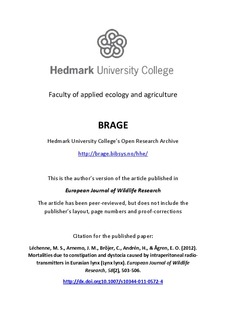| dc.contributor.author | Léchenne, Monique S. | |
| dc.contributor.author | Bröjer, Caroline | |
| dc.contributor.author | Arnemo, Jon Martin | |
| dc.contributor.author | Andrén, Henrik | |
| dc.contributor.author | Ågren, Erik O. | |
| dc.date.accessioned | 2012-08-27T11:04:53Z | |
| dc.date.available | 2012-08-27T11:04:53Z | |
| dc.date.issued | 2012 | |
| dc.identifier.citation | Léchenne, M. S., Arnemo, J. M., Bröjer, C., Andrén, H., & Ågren, E. O. (2012). Mortalities due to constipation and dystocia caused by intraperitoneal radio- transmitters in Eurasian lynx (Lynx lynx). European Journal of Wildlife Research, 58(2), 503-506. | no_NO |
| dc.identifier.uri | http://hdl.handle.net/11250/134472 | |
| dc.description | This is the preprint version of the article. The original publication is available at www.springerlink.com | no_NO |
| dc.description.abstract | Three lynx (Lynx lynx) were found dead following complications after a surgically implanted free floating intraperitoneal radio-transmitter became lodged within the pelvic canal. Two yearling lynx died due to consequences following severe constipation as the transmitter compressed the colon. Both were emaciated, with no abdominal or intrapelvic fat, which allowed the transmitter implant to fit into the pelvic canal. An adult female lynx died of dystocia when the pelvic birth canal was blocked by the transmitter when parturition began, leading to uterine rupture and subsequent peritonitis. A total of 41 lynx was implanted with this type of intraperitoneal transmitter in Scandinavia 1997-2002. After the three transmitter-associated mortalities, the transmitter type used in lynx cubs was exchanged for another model, and further fatalities due to the implants have not been documented. | no_NO |
| dc.language.iso | eng | no_NO |
| dc.publisher | Springer-Verlag Heidelberg | no_NO |
| dc.subject | implant | no_NO |
| dc.subject | lynx | no_NO |
| dc.subject | mortality | no_NO |
| dc.subject | radio-transmitter | no_NO |
| dc.subject | wildlife | no_NO |
| dc.title | Mortalities due to constipation and dystocia caused by intraperitoneal radio- transmitters in Eurasian lynx (Lynx lynx) | no_NO |
| dc.type | Journal article | no_NO |
| dc.type | Peer reviewed | no_NO |
| dc.subject.nsi | VDP::Mathematics and natural science: 400::Zoology and botany: 480 | no_NO |
| dc.source.pagenumber | 503-506 | no_NO |
| dc.source.volume | 58 | no_NO |
| dc.source.journal | European Journal of Wildlife Research | no_NO |
| dc.source.issue | 2 | no_NO |
| dc.identifier.doi | 10.1007/s10344-011-0572-4 | |
